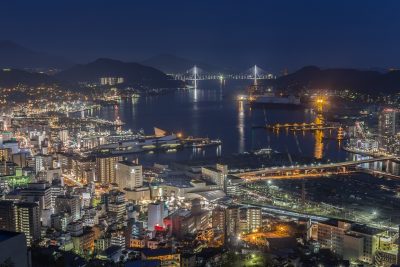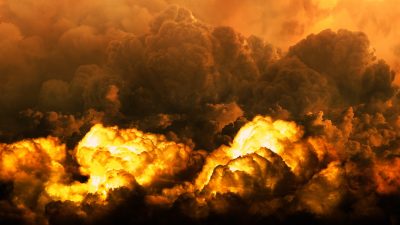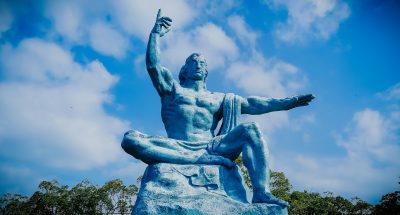Nagasaki City, a port-city, that spreads from sea to mountain-side. Located on Japan’s 3rd largest island- Kyushu- it faces southwest into the East China Sea. From Tokyo it’s two hours plane or seven hours by train. Tourist attractions include the Peace Park & the nation’s oldest wooden Christian church- the Oura Catholic Church.
Nagasaki’s location influenced the Japanese government’s decision in 1571 to open the port for trade with Portugese ships. By 1635 Nagasaki had the distinction of being the only port in Japan where trade was permitted with foreign nations.

Prior to the closure of the nation under the edict of “Sakoku” in 1635 however Nagasaki was the centre of Christian culture in Japan. Despite Christianity having only been introduced to the area by Francis Xavier in 1549, Nagasaki by 1580 was known as “Little Rome”.
Japan-Closed for Business
Japan was ruled by the Tokugawa shogunate from 1600 until the Meiji Restoration in 1868. Tokugawa Ieyasu, first of the shoguns, was concerned about exposing Japanese people to Western ideas. His concerns were heightened when Europeans began establishing Asian colonies such as the Spanish conquest of the Philippines.
In 1587 an edict was issued outlawing Christianity and expelling the missionaries who by that time had converted over 150,000 Japanese to the faith. Due to the number of feudal barons and samurai in that number the edict was not strictly heeded.
The 26 Martyrs of Japan
Hostility and fear towards Christianity fuelled an eventual response. In 1597, 26 Catholics- 4 x Spanish, 1 x Mexican, 1 x Indian, all of whom were Jesuit missionaries, along with 17 x Japanese laymen, were executed by crucifixion in Nagasaki.
Sakoku becomes Policy
Intervening decades saw Japan move closer to a policy of complete exclusion from the outside world. By the 1630’s Japan had enforced “Sakoku”- a policy of national exclusion.
No Japanese ships or people could go abroad.
Christianity was punishable by imprisonment
Portugese ships were banned.
However Nagasaki, as a port-city, remained open to Chinese merchants and traders of the Dutch East Company. The policy remained in place until two hundred years later when Commodore Perry of the United States Navy used “gunboat diplomacy” to open Japan up to U.S trade.
From Strength to Strength
With diplomatic relations restored Nagasaki continued to thrive. Christians who had long hidden their faith re-emerged and by 1873 the ban on Christianity was lifted.
In 1895 Christians built the Urakami Cathedral , the first of its kind in Asia. By 1945 there were an estimated 50,000 Christians living in the city out of a population of 263,000 people.
A Mixed Blesssing
In August 1945 an ill-wind was blowing for the people of Nagasaki. On Tinian island, one of the Northern Marian islands, a Catholic chaplain with the U.S Air Force, George Zabelka, blessed two atomic bombs. He later admitted this to be a grave moral mistake.
About the Bomb
The bomb that was dropped over Nagasaki on August 9th, 1945 weighed five tons and was known as “The Fat Man”. The blast created 624 mph/winds and produced heat upwards of 7,000 degrees. The bomb killed 75,000 people of which only 150 were soldiers. More Japanese Christians were killed in seconds than had been persecuted in 500 years.
Why Nagasaki?
William Laurence, a New York Times reporter reported that, “Destiny chose Nagasaki as the ultimate target”. However Nagasaki did not previpusly appear on any target list drawn up in advance. The main targets were Kyoto, Hiroshima, Yokohama & Kokura- also located on the island of Kyushu. Kyoto was excluded due to its cultural importance dragging Niigata, as a runner-up, into the list.
General Leslie Groves, who directed the top secret Manhattan Project, said he had never worked out how Nagasaki was chosen. Initially included in a list of 17 targets it had been removed in May 1945- partly due to the fact that it was the location for a Prisoner of War camp.
Indeed Nagasaki was not the primary target that fateful day. Kokura, with “one of the largest arsenals in Japan” was. According to the Enola Gay, now serving as a weather plane, weather conditions were good over Kokura. Somehow however the B-29 bomber carrying the atomic bomb delayed and by the time it arrived over Kokura the weather had changed. A decision was made to aim for the secondary target. Nagasaki’s fate was sealed.
A Direct Hit?

Nagasaki’s Ground Zero became the Urakami Cathedral despite the aiming point being the Mitsubishi Steel & Arms Works. From a military perspective if the bombing of Hiroshima was well planned and well executed, Nagasaki was the opposite.
Was the bomb necessary?
U.S Admiral William D. Leahy expressed his opinion that neither of the bombs were of “material assistance in the war against Japan”. Eisenhower concurred when in July 1945 he stated it wasn’t necessary to hit Japan “with that awful thing”.
Even President Truman seemed surprised by the second bombing and issued an immediate order to stop any future bombing without his direct approval.
Later in 1946, Fleet Admiral William Halsey, made a public statement that the atomic bombs had not been decisive in ending the war.
While the effects of the bomb were being understood by the world at large propaganda leaflets were belatedly air-dropped warning the people of Nagasaki about the possible shock to come.
A Means to an End
A narrative was popularized giving the impression that those involved had predicted the bombings would end the war. Susan Southard of the New York Times adds her dissenting voice and is convinced that the Soviet Union’s decision to end the war – just 11 hours before the bombing of Nagasaki- was just as influential.
From the Ashes
No matter what your view of history the legacy of Nagasaki lives on.The use of an atomic bomb was a moral step backward for humanity. Nagasaki, however, lives on.
In 1945 a small community of 8 Jesuit Fathers living less than a mile from the detonation points survived unscathed. Their presbytery the only building remained standing when all around was flattened.
Many of the Japanese survivors, known as “hibakusha” have used their horrific experiences to ensure history is never repeated.
The bomb blast destroyed one-third of Nagasaki City and it was said at the time the area would be devoid of vegetation for 75 years. Today the detonation point is an international Peace Park and welcoming of foreign visitors.

“Like a phoenix reborn from the ashes, like a flower grown out of stone, mankind affirms its existence when peace reigns over the Earth.”- from a plaque in Nagasaki’s Peace Park


